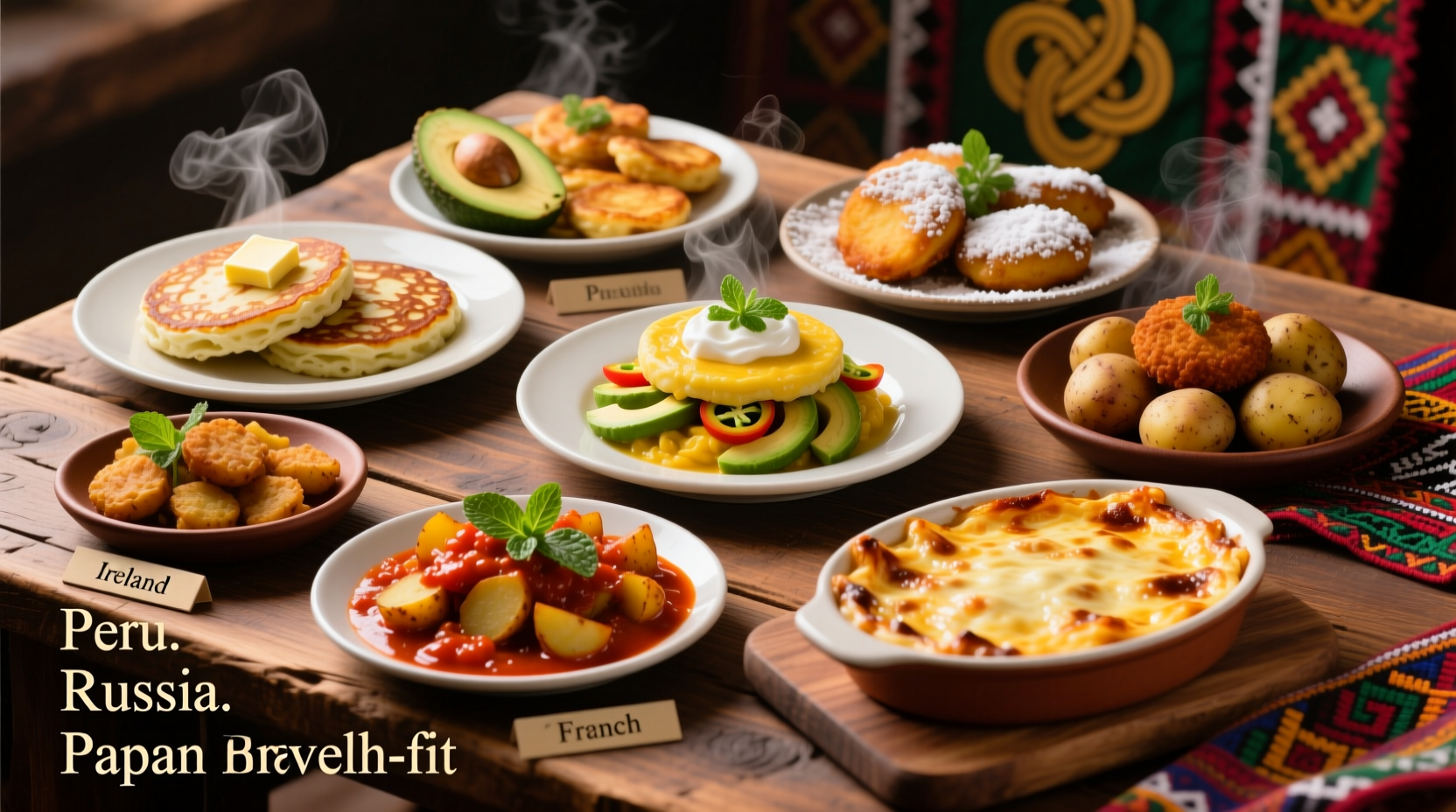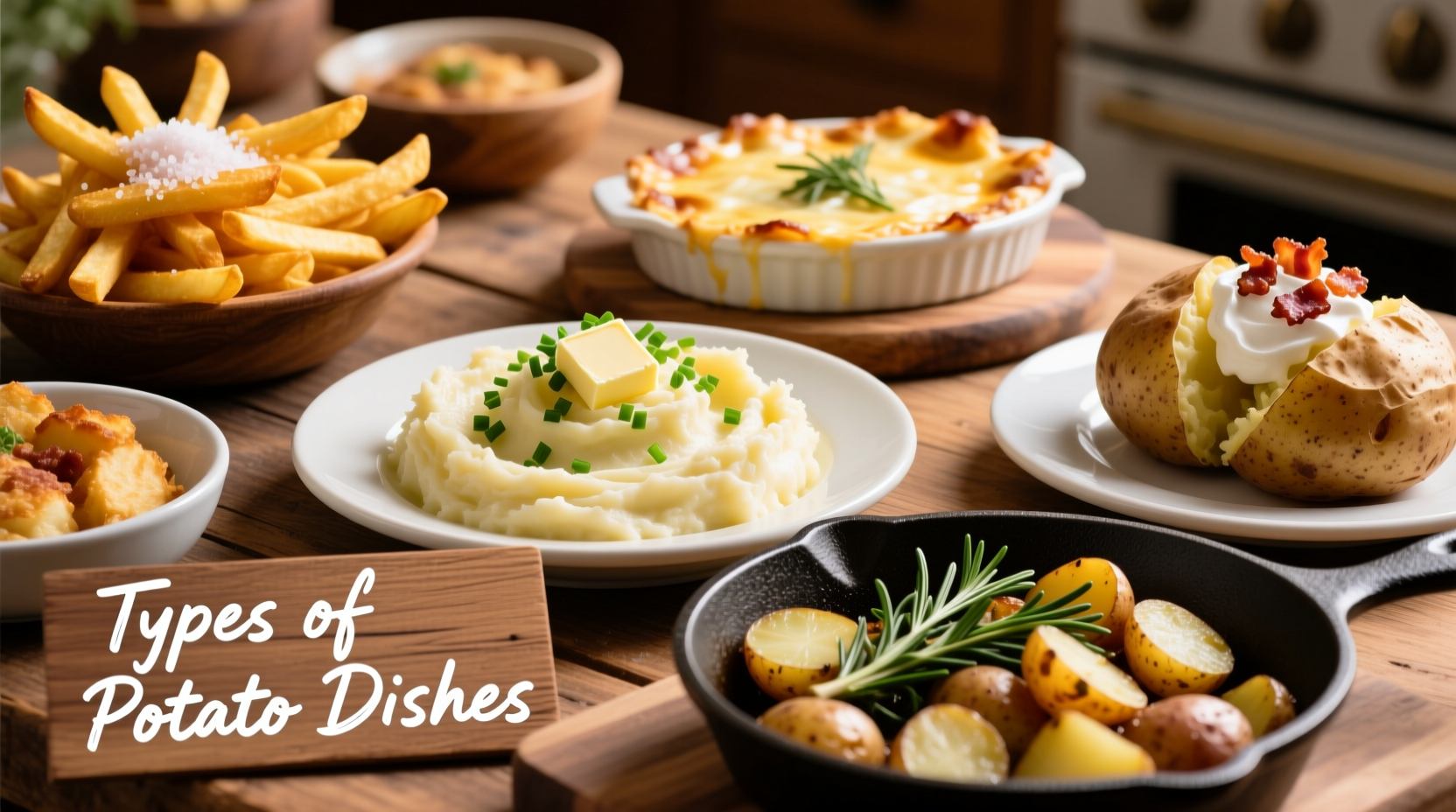There are over 30 major types of potato dishes worldwide, categorized by preparation method (boiled, baked, fried, mashed), cultural origin (European, American, Asian), and meal function (main course, side dish, breakfast item). The best potato dish depends on the potato variety's starch content, with high-starch potatoes ideal for frying and mashing, while waxy varieties work best for boiling and salads.
Discover the incredible versatility of potatoes with this comprehensive guide to global potato dishes. Whether you're looking for comforting classics, regional specialties, or modern culinary innovations, understanding the different types of potato dishes transforms how you use this humble tuber. This guide reveals not just what these dishes are, but when to serve them, which potato varieties work best, and the cultural stories behind each preparation method.
Understanding Potato Dish Categories by Preparation Method
How potatoes are cooked dramatically affects their texture, flavor, and ideal applications. The four primary preparation methods create distinctly different culinary experiences:
Boiled and Steamed Potato Dishes
Boiling preserves potato shape while creating a firm yet tender texture perfect for salads and side dishes. Waxy potato varieties like Yukon Gold or Red Bliss maintain their structure when boiled, making them ideal for:
- Potato salad - Classic cold preparation with mayonnaise or vinaigrette
- Germknödel - Austrian dumplings with plum filling
- Variety of international potato soups including Spanish Puré de Patatas
Baked and Roasted Potato Creations
Dry-heat cooking creates delicious caramelization and concentrated flavor. High-starch potatoes like Russets develop the perfect crispy exterior while maintaining fluffy interiors. These preparations shine as:
- Traditional baked potatoes - The ultimate comfort food with endless topping possibilities
- Roasted potato wedges - Seasoned with herbs and olive oil
- Papas arrugadas - Canarian wrinkled potatoes with mojo sauce
- Gratin dauphinois - French baked potato slices in cream
| Dish Type | Recommended Potato | Why It Works |
|---|---|---|
| Fried dishes | Russet, Maris Piper | High starch creates crisp exterior while remaining fluffy inside |
| Mashed potatoes | Yukon Gold, Russet | High starch content yields creamy, smooth texture |
| Boiled/salad dishes | Red Bliss, Fingerling | Waxy texture holds shape when cooked |
| Roasted dishes | Sweet potato, Purple potato | Color contrast and unique flavor profiles |
Regional Potato Specialties Around the World
Potatoes traveled from their Andean origins to become culinary staples worldwide. Each region developed distinctive preparations reflecting local ingredients and traditions. Understanding these cultural contexts helps you select authentic potato dishes for different occasions.
European Potato Traditions
Europe embraced potatoes after their introduction from South America, creating iconic dishes that became national treasures:
- Galette de sarrasin (France) - Buckwheat crepes often filled with potato and cheese
- Rösti (Switzerland) - Shredded potato pancake, traditionally a breakfast dish
- Colcannon (Ireland) - Mashed potatoes with kale or cabbage
- Bramborák (Czech Republic) - Potato pancakes with herbs and spices
American Potato Innovations
From North to South America, potato dishes reflect diverse cultural influences:
- Poutine (Canada) - French fries with cheese curds and gravy
- Chorreadas (Costa Rica) - Potato and corn pancakes
- Papas rellenas (Latin America) - Stuffed potato balls with meat filling
- Hash browns (USA) - Shredded potatoes fried until crispy

When to Serve Different Potato Dishes: Context Matters
Not all potato dishes work for every occasion. Understanding the appropriate context for each preparation ensures your meal planning succeeds:
Breakfast Potato Dishes
Morning potato preparations typically feature crispy textures and simple seasonings that complement eggs:
- Home fries - Cubed potatoes pan-fried with onions
- Hash browns - Shredded potatoes formed into patties
- Rösti - Swiss shredded potato pancake
Best served with: Eggs, bacon, and fresh fruit. Avoid heavy cream-based preparations at breakfast.
Main Course Potato Dishes
Substantial potato preparations that can anchor a meal:
- Papas rellenas - Stuffed potato balls with meat filling
- Tortilla española - Spanish omelet with potatoes
- Shepherd's pie - Meat filling topped with mashed potatoes
Best served with: Simple vegetable sides. These dishes already contain substantial carbohydrates.
Evolution of Potato Cuisine: From Ancient Staple to Modern Masterpiece
The journey of potatoes from Andean mountains to global kitchens spans centuries and reflects remarkable culinary adaptation. According to research from the International Potato Center (CIP), this evolution follows distinct phases:
- Pre-1532: Potatoes cultivated in the Andes with over 4,000 native varieties
- 1532-1700s: Introduction to Europe, initially met with suspicion but gradually adopted
- 1800s: Potato becomes staple food across Europe, leading to diverse regional preparations
- Early 1900s: Industrialization creates standardized preparations like french fries
- Late 1900s-Present: Global fusion cuisine creates innovative potato dishes blending traditions
This historical progression explains why certain preparations dominate in specific regions. For example, the Irish reliance on potatoes during the 18th and 19th centuries led to simple, hearty preparations like colcannon, while French culinary refinement produced sophisticated dishes like gratin dauphinois.
Modern Interpretations of Classic Potato Dishes
Contemporary chefs continue to innovate with potato dishes, creating exciting new preparations while honoring traditional techniques:
- Deconstructed potato salad - Individual components presented artistically
- Potato gnocchi with unexpected sauces - Like brown butter sage or truffle variations
- Layered potato terrines - Thinly sliced potatoes with alternating ingredients
- Infused potato chips - House-made chips with unique flavor infusions
These modern interpretations maintain the essential potato character while offering new sensory experiences. The key to successful innovation is understanding the fundamental properties of potatoes that make traditional dishes work.
Choosing the Right Potato for Your Dish
Selecting the appropriate potato variety is crucial for dish success. Potatoes fall into three main categories based on starch content:
- Starchy potatoes (Russet, Idaho) - Best for baking, mashing, and frying
- Waxy potatoes (Red Bliss, Fingerling) - Ideal for boiling, salads, and roasting
- All-purpose potatoes (Yukon Gold) - Versatile for most preparations
According to USDA agricultural research, starch content directly affects texture outcomes. High-starch potatoes absorb liquid well, creating fluffy mashed potatoes, while waxy varieties maintain structure in salads. Understanding these properties prevents common cooking failures like mushy potato salad or dry roasted potatoes.











 浙公网安备
33010002000092号
浙公网安备
33010002000092号 浙B2-20120091-4
浙B2-20120091-4